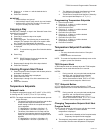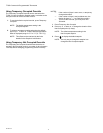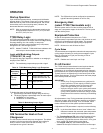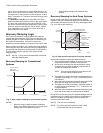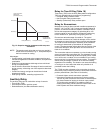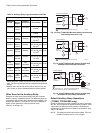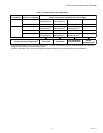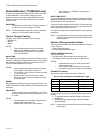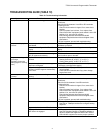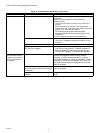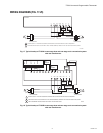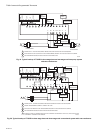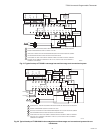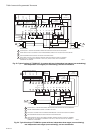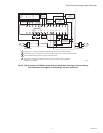
T7350 Commercial Programmable Thermostat
63-2605—06
24
Dehumidification (T7350D,M,H only)
There are five methods through which the T7350 can control
for dehumidification. Three of them modify the control
algorithm, thus providing limited dehumidification through
cooling. The other two use the auxiliary output to control
another device.
IMPORTANT
Configurable only with a PDA, TStatSpec software, or
a network tool such as LonSpec or CARE.
NOTE: The dehumidification high limit can be set within the
range of 10 to 90 percent relative humidity.
Control Through Cooling
Configure using some combination of the following:
— Minimum On.
— Reheat.
— Reset.
NOTES:
— These methods operate only during cooling.
— Selecting both Reheat and Reset can cause
frequent setpoint adjustments. This selection
is not recommended.
MIN ON TIME
Dehumidifies by increasing the compressor minimum on time
(normally 3 minutes) by a programmable amount. This is useful
with oversized systems in that it forces the coils to cool to a
point where dehumidification can occur.
NOTES:
— Can force wider temperature swings by cooling
when setpoint control does not require it.
— The minimum on time can be set within the range
of 5 to 15 minutes.
— Hysteresis and a minimum timer are used to
ensure this behavior does not change with every
equipment cycle.
REHEAT
Dehumidifies by operating cooling during typical off time. The
T7350 maintains the proper setpoint by running the heat at the
same time.
IMPORTANT
At times during Reheat dehumidification, the T7350
operates heating and the cooling simultaneously. This
is normal.
NOTES:
— The heat stage never energizes during Reheat if
more than one cool stage is on.
— Reheat mode cannot occur during heating.
— The T7350H1017, T7350M do not support the
Reheat method.
RESET TEMP SETPT
The room temperature set point resets to a specified number of
degrees below the actual set point when room relative humidity
(RH) rises above humidity high limit.
Though this may not technically reduce RH, it reduces the dew
point to provide the customer with a sense of comfort due to a
lower temperature setting in the room.
As long as RH stays above humidity high limit, this set point is
maintained.
NOTE: Hysteresis and a minimum timer prevent the set point
from short interval alternation (between standard and
reset set points).
Options Utilizing Auxiliary Output
There are two dehumidification options that utilize the auxiliary
output. They are:
— Simple Dehumidification.
— Hot Gas Bypass Dehumidification.
SIMPLE DEHUMID(IFICATION)
The auxiliary output:
— Energizes when RH rises above humidity high limit.
— De-energizes when RH drops below humidity high limit.
NOTES:
— Hysteresis and a minimum timer prevent short
cycling of this output.
— Unlike Dehumid Hot Gas BP the relay remains
energized during calls for multiple cooling stages.
DEHUMID HOT GAS BP
The auxiliary output operates as shown in Table 18.
Table 18. Hot Gas Bypass Dehumidification Logic.
Auxiliary output during call for multiple cooling stages for two
reasons:
1. This method assumes that the cooling provides dehu-
midification.
2. Multiple cooling stages probably provide necessary
dehumidification.
NOTE: Hysteresis and a minimum timer prevent short cycling
of this output.
Humidity Cooling Stages Active Auxiliary Output
High more than one De-energized
High one or less Energized
Low more than one De-energized
Low one or less De-energized




